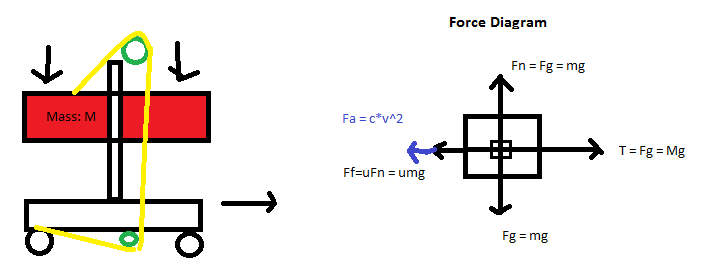I was trying to find the distance a machine system I designed would potentially go. The machine works like this: A mass $M$ drops down and through a system of pulleys, pulls a wheel wound with the cable which pushes the system forward. Given a speed of wind $w$, coefficient of friction $\mu$, mass of entire system $m$, and the force of air resistance $F_a=c(w+v)^2$, and a maximum drop height $h$ before the cable fully unwinds from the wheel and let's go of it, what is the maximum distance $s$ the system will travel?
$_{ \text {(pardon my mspaint)} }$
My Work: I first split this up into two problems: Find the kinetic energy of the velocity after the cable has been detached based on work, then set that kinetic energy equal to the work done by air resistance and friction.
$W_1 = \int (\sum F_x)\cdot v \ \mathrm dt$
$W_1 = \int v(c(w+v)^2+g(M -\mu m)) \ \mathrm dt$$W_1 = \int v(-c(w+v)^2+g(M -\mu m)) \ \mathrm dt$
$W_1 = \int (cw^2v+2cwv^2+cv^3+gv(M -\mu m)) \ \mathrm dt$$W_1 = \int (-cw^2v-2cwv^2-cv^3+gv(M -\mu m)) \ \mathrm dt$
But since $v = {\ \mathrm ds \over \ \mathrm dt}$, things get really weird, as:
$W_1 = c \int (w^2{\ \mathrm ds \over \ \mathrm dt} + 2w({\ \mathrm ds \over \ \mathrm dt})^2 + ({\ \mathrm ds \over \ \mathrm dt})^3) \ \mathrm dt + g \int {\ \mathrm ds \over \ \mathrm dt} (M -\mu m) \ \mathrm dt$$W_1 = -c \int (w^2{\ \mathrm ds \over \ \mathrm dt} + 2w({\ \mathrm ds \over \ \mathrm dt})^2 + ({\ \mathrm ds \over \ \mathrm dt})^3) \ \mathrm dt + g \int {\ \mathrm ds \over \ \mathrm dt} (M -\mu m) \ \mathrm dt$
$W_1 = c \int w^2 \ \mathrm ds + \int 2w({\ \mathrm ds \over \ \mathrm dt} + ({\ \mathrm ds \over \ \mathrm dt})^2) \ \mathrm ds + g \int (M -\mu m) \ \mathrm ds $$W_1 = -c \int w^2 \ \mathrm ds + \int 2w({\ \mathrm ds \over \ \mathrm dt} + ({\ \mathrm ds \over \ \mathrm dt})^2) \ \mathrm ds + g \int (M -\mu m) \ \mathrm ds $
$W_1 = \int (2w{\ \mathrm ds \over \ \mathrm dt} + ({\ \mathrm ds \over \ \mathrm dt})^2) \ \mathrm ds + gs(M -\mu m) + csw^2$$W_1 = -c \int (2w{\ \mathrm ds \over \ \mathrm dt} + ({\ \mathrm ds \over \ \mathrm dt})^2) \ \mathrm ds + gs(M -\mu m) - csw^2$
And I could be wrong, but that looks like a really invalid integral, so how might one solve this problem? I'm thinking there should be a way to do it with Diff. EQ, but am yet to figure that out.
